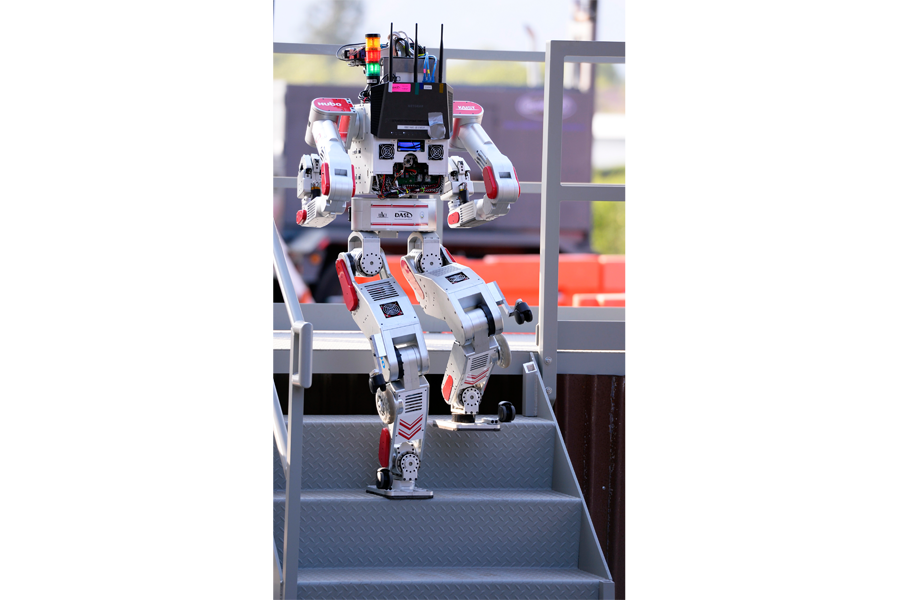South Korean team wins $2 million to design robots for humanitarian aid
Loading...
| Pomona, C.A.
A robotics team from South Korea took home the $2 million first-place prize in a competition this weekend to design robots that could aid humans in a natural or man-made disaster.
During the DARPA Robotics Challenge Finals, which took place here Friday and Saturday (June 5 and 6), the winning team's DRC-HUBO robot finished all eight tasks in less than 45 minutes. The winning bot had a humanoid design that could transform itself into a wheeled kneeling position for faster, more stable movement.
The Running Man robot from Florida's Institute for Human and Machine Cognition claimed second, finishing all the tasks in just over 50 minutes. Team Tartan Rescue's CHIMP robot came in third, completing all the tasks in just over 55 minutes. The second and third place teams took home $1 million and $500,000, respectively.
"Today was incredible. It was everything we hoped it would be and more," Gill Pratt, the DARPA program manager in charge of the challenge, said in a news conference today. But robotics is still in a "young age," he said.
The U.S. Defense Advanced Research Projects Agency started the challenge in 2012. The competition was inspired by the Fukushima Daiichi nuclear disaster, caused by the deadly 2011 earthquake and tsunami in Japan. The idea was to develop robots that could aid emergency responders in disaster recovery efforts by going places that are unsafe for humans. [See Photos of the Robot Competitors in Action]
The 25 teams had two chances to complete as many as possible of the course's eight tasks, which included driving a utility vehicle, exiting the vehicle, opening a door, cutting a hole in a wall, walking over a pile of rubble (or clearing a path through debris), walking up a short flight of stairs, and completing a surprise task, which was different each day.
The bots had to complete the course without a tether to prevent them from falling over and despite a disrupted communications link between the bots and their human operators.
After the first day of competition, Carnegie Mellon University's CHIMP robot (short for CMU Highly Intelligent Mobile Platform) was in the lead, becoming the first team to complete all eight tasks in the hour allotted. CHIMP was followed by the German Team NIMBRO RESCUE's robot Momaro and the Jet Propulsion Laboratory's RoboSimian robot, which scored seven points each during the first day.
But the second day of competition brought an upset by South Korea's team KAIST, whose robot leaped into first place after finishing all eight tasks in less time than CMU's CHIMP robot — including the surprise task, which involved unplugging a wire and plugging it into another outlet. Team IHMC also completed all eight tasks on the second day to claim second place, bumping CHIMP into third.
Though the field of robotics still has a long way to go, the teams made some impressive strides in robotic technology. But even more surprising was the way the audience reacted to the robots, Pratt said. "We have robots that look like the Terminator," he said, and yet spectators fell in love with them, cheering when the robots succeeded and feeling sorry for them when they failed. "There is some incredible, untapped affinity for machines," Pratt said.
Top 10 team rankings:
1. TEAM KAIST (8 points, 44:28 minutes)
2. TEAM IHMC ROBOTICS (8 points, 50:26 minutes)
3. TARTAN RESCUE (8 points, 55:15 minutes)
4. TEAM NIMBRO RESCUE (7 points, 34:00)
5. TEAM ROBOSIMIAN (7 points, 47:59 minutes)
6. TEAM MIT (7 points, 50:25 minutes)
7. TEAM WPI-CMU (7 points, 56:06 minutes)
8. TEAM DRC-HUBO @ UNLV (6 points, 57:41 minutes)
9. TEAM TRAC LABS (5 points, 49:00 minutes)
10. TEAM AIST-NEDO (5 points, 52:30 minutes)
Follow Tanya Lewis on Twitter. Follow us @livescience, Facebook& Google+. Original article on Live Science.
- Gallery: Robots Face Off in DARPA Robotics Challenge Finals
- Humanoid Robots to Flying Cars: 10 Coolest DARPA Projects
- Super-Intelligent Machines: 7 Robotic Futures
Copyright 2015 LiveScience, a Purch company. All rights reserved. This material may not be published, broadcast, rewritten or redistributed.







